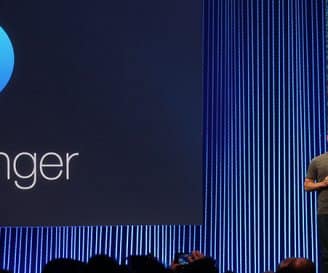
Facebook totally took over the social media news this week due to Facebook F8 Developers Conference. It’s an annual event organized in San Francisco where Mark Zuckerberg gets to talk about new Facebook features and products. Developers develop their ideas through the so-called “eight-hour hackatons” (hence F8).
This year at Facebook F8 Mark introduced us to the 10-year strategy/ technology roadmap starting off with: improving Facebook as an integrated ecosystem within the next 3 years; Facebook products and features (e.g. Groups or Search) within the 5 year period; and venturing into Artificial Intelligence, VR and Connectivity in the next 10 years.
Everything You Need to Know about Facebook F8 New Features
1Instant Articles are now live
Instant Articles are now live
Facebook has announced the introduction of Instant Articles a while ago, but this time the product is ready for everyone. What is it exactly? I wrote about the new Canvas format and Instant Articles in this blog post, however the idea in short is about building an unique reading experience within Facebook that will take over your entire mobile screen. From now on every time you post on your Facebook page, Facebook will open your article in Instant Articles – it will take over the entire screen on your mobile device and will load very quickly.
Note! Facebook will not redirect a reader to your blog or website – the audience stays within Facebook. The main benefit though is improved reading experience – the format is neat and clean and if this will get your content appreciated more, you might eventually bite the dust of “lost” potential traffic. You can sign up for Instant Articles here as this feature is open for all type of publishers. If you have a WordPress site, there is a WP plugin available. I already installed it on my site and mobile and I explained step by step how to set up Facebook Instant Articles here.
2Messenger and Bots – what does this mean?
Messenger and Bots – what does this mean?
Just like with Instant Articles, Facebook announced that Messenger and Bots platform is now officially open to developers. What does “Bot” really mean? Facebook will now let you communicate with your Messenger app (either by typing or with voice recognition) and come back with suggestions, e.g. say you want to order a veggie pizza in the neighborhood and Messenger will send you suggestions and a question to order immediately.
As part of the new Messenger Platform, bots can provide anything from automated subscription content like weather and traffic updates, to customized communications like receipts, shipping notifications, and live automated messages — all by interacting directly with the people who want to get them. The Messenger Send / Receive API will support not only sending and receiving text, but also images and interactive rich bubbles containing multiple calls-to-action.
It’s an amazing presentation of where Facebook’s Artificial Intelligence is at the moment. Facebook is developing it’s virtual assistant “M” (similar to Siri or Cortana) and from now on will let developers build their own “bots”. What does this mean exactly?
There’s a CNN bot developed already that tells you about current news or topics you’re interested in. Local retailers can create their own bots to reach their customers through Messenger. During the F8 Conference few of the examples were shown already – see this article from The Next Web.
3What’s new with Profile Pictures… or Videos?
What’s new with Profile Pictures… or Videos?
Do you use the new “Profile Video” on Facebook already? Or perhaps you’ve heard about the filters you can apply on your profile pictures? Well Facebook is just about to make them more interesting for you. They launched “Facebook Profile Expression Kit” which allows developers sync their apps with the profile video feature.
What this means exactly is say e.g. you’re using an Instagram app Boomerang or any other similar app where you create a video and immediately share it as a Facebook Profile Video. Right now the kit is still in closed beta, but it already supports those apps: Boomerang by Instagram, Lollicam, BeautyPlus, Cinemagraph Pro by Flixel, Lollicam, MSQRD, and Vine. Have you tried them already?
4Save button available on all pages
Save button available on all pages
Facebook also works hard on improving it’s “Save for later” function. You might have used it on existing Facebook pages, posts or videos. Right now, Facebook has introduced a new “Save” button, where readers can save everything outside Facebook – that is articles, videos, and products.
Everything will be saved into their Saved folder on Facebook, where they can easily access it later from any device. You will probably get notifications about your saved content when you haven’t come back to it in a while, just like it happens right now with saved pages: At relevant times, we’ll also remind people about their saved things — like when a product goes on sale, or if they’ve saved an article they haven’t read yet. This is obviously a smart technique to learn even more about Facebook users – what do they like, what do they read and what do they want to buy. I’m pretty sure this will be a great add-on for targeting possibilities on Facebook Ads Manager.
5Crossposted videos
Crossposted videos
It sounds very sophisticated and complicated but the principle is quite simple – sharing the same video across different Facebook pages (if you manage more than one). This is more relevant to media agencies and bigger publishers who indeed have multiple Facebook pages and sometimes have an overlap in content creation. This means they need to share the same (native) video across different pages and hence the “viral” aspect of the video disappears as it’s not one video anymore. Facebook will let you now “crosspost it”, meaning you can reuse the existing post from one page on another one. What’s even cooler are the insights – you will see total performance insights for a single video across all the places it was used, e.g. the total view count of one video.
6Quotes featured in Facebook posts
Quotes featured in Facebook posts
Facebook has also improved their timeline by adding a new feature called “Quote Sharing”. From now on you can select the piece of article, a blog post or an interview and immediately share it on Facebook. No this doesn’t mean copy and paste into Facebook post update – this is actually sharing the quote directly from where you’ve found it. How does this work exactly?
If a website has this short piece of code( <div class=”fb-quote”></div>) and Facebook SDK (software development kit) installed already, when selecting text, a button “Share Quote” will popup. It will then open up a regular Facebook post window (just like you e.g. want to share the article on Facebook directly from the website) with the quote written down and a thumbnail of the article underneath.
7Sample Text
Sample Text
Continuing with improved timeline experience, Facebook also introduced a minor tweak to embed functions – you can now embed any comment shared on business pages (not for private pages). It looks like this:
Once the comment is embedded e.g. on your blog or website, you can like it or see the replies. If you want to comment, it will take you to the post within Facebook. It looks just like that:
8Log in to an app with a two step verification process
Log in to an app with a two step verification process
This is more of a technical feature, but it’s for sure relevant to all of you who develop apps or products that make use of certain Facebook elements such as e.g. logins. You might sometimes see this when a login window opens and there are more options than your e-mail address, e.g. login via Twitter or Facebook account. During the Facebook F8 Conference it’s been announced that Facebook will allow 3 different ways of logging in – via Facebook account, e-mail address or mobile number. The second verification step will be communicated via your mobile phone – you’ll get an SMS with a verification code.










